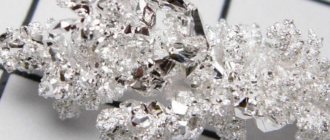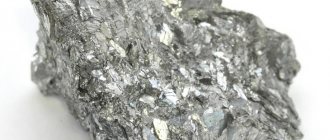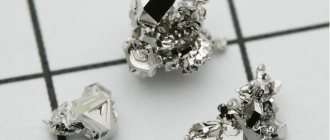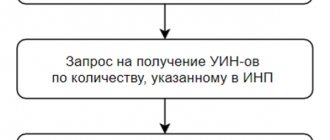Physical properties
Palladium was first discovered by the English chemist William Wollaston in 1803. The metal got its name from the asteroid Pallas. The asteroid was discovered shortly before the element was obtained in the laboratory.
Palladium has a silvery-white color. The appearance of the metal resembles silver. Platinite has the following physical properties:
- metal density – 12.0 g/cm3;
- melting point – 1554°C;
- hardness on the Brinell scale – 52 kgf/mm2;
- metal boiling point – 2940°C;
- elastic modulus of platinite – 12600 kgf/mm2.
For your information. Palladium is the rarest substance on earth. The content of this element in the earth's crust does not exceed 0.000001%.
The structure of the metal changes already at a temperature of 18–20°C. Further heating makes these changes irreversible.
The addition of substances from the platinum group elements significantly improves the properties of palladium. For example, the addition of ruthenium and rhodium doubles the tensile strength of the chemical element.
Market Forecast
There is a clear consensus among market participants and external analysts that the palladium market will experience a shortage in the next few years, as demand is growing steadily due to increased car production, and supply is approximately at the same level and the introduction of new large capacities in the next few years is not planned. For example, Citi predicts an increase in the price of palladium to $1200-1300 in 2019-2020.
The key risk in terms of demand for palladium is the global economic crisis (if it happens), which will likely result in reduced car production and, accordingly, fewer catalysts will be needed (this situation last occurred during the crisis in 2008-2009 years when the price of palladium fell below $200). However, it is far from certain that it will happen in the next few years, and even if it does happen, that it will be deep enough for car production to be significantly reduced.
From a supply side, there are no plans to launch significant new fields or expand existing ones in the next few years. Norilsk Nickel recently presented a new strategy, according to which it plans to increase palladium production by 25%, but according to plans this will happen only by 2025. And in the next 2-3 years, on the contrary, there is a possibility of a reduction in supply in South Africa - since the deposits there have a higher content of platinum, prices for which have fallen sharply, some companies are planning to optimize or stop work on part of the deposits. In particular, Impala Platinum (currently the top 3 palladium producer) has already announced such plans.
Schedule 22
The long-term risk for the demand for palladium is electric cars - if they replace cars with internal combustion engines, the demand for palladium will fall by 80%, since electric cars do not need catalysts (no exhaust gases), but this is definitely not a prospect for the next 3-5 years.
Schedule 23
Chemical properties
Palladium is characterized by high inertness and galvanic resistance. These properties are explained by the peculiarity of its atomic structure. The metal does not interact with water molecules, acids and alkalis.
When heated to a temperature of 300–350°C, the stability of the substance is stable. With further heating, the metal is oxidized by oxygen. The result of the chemical reaction is the appearance of a dull oxide film on the surface of the substance.
When heated to 800–850°C, the substance decomposes. In this temperature range, the metal becomes resistant to oxidation.
This is interesting! A nitric acid solution thins a pure titanium plate by 19 mm per year. An alloy of titanium and palladium reduces this rate to 0.10 mm per year.
At temperatures of 500°C and above, the metal interacts with fluorine and other oxidizing agents.
Palladium enhances the anti-corrosion properties of titanium. The addition of platinum significantly increases the resistance of titanium to aggressive environments.
Why palladium?
The most common question from people new to precious metals trading is why should you consider palladium? There is no clear answer, just as it is difficult to say why most people choose to buy gold over silver, given that they have a high degree of price correlation.
Palladium is of very great practical importance ; it is actively used in the following industries:
- Jewelry . Alloys with gold and silver are common. Jewelry is rarely made from pure palladium, but in general the metal is in demand, since even in a very low concentration it can color the resulting alloy, for example, white gold.
- Electronics . Like gold, palladium is often used in the manufacture of complex devices.
- Automotive industry . Many will be surprised, but almost every car with a conventional engine contains palladium elements - catalysts. This direction of consumption, according to various estimates, ranges from 60% to 75% of all palladium consumption. Accordingly, if car sales grow, demand also grows.
- Medicine . Some instruments are made using this metal, as well as complex equipment - pacemakers.
The most important reason to consider investing in palladium is the almost continuously growing demand. Every year more and more cars are produced, and we are talking about the most ordinary cars, and not electric cars. The green direction is, of course, developing, but traditional internal combustion engines are still out of reach for now. Therefore, given the limited production capabilities, metal producers will raise prices in conditions of high demand.
However, one important fact must be taken into account: in the United States there are signs of a bubble in the auto loan market. This means that at some point a collapse may occur and sales of new cars will collapse. Accordingly, the price of metal will fall. Therefore, when deciding whether to invest in palladium, you need to take into account that you will have to be interested in the global economy. So far, everything is in order and no crisis is foreseen, and perhaps even this problem will be extinguished before it becomes large-scale.
In general, everything is far from clear, only one thing can be said with confidence - investing in palladium will require time to study the market, you will have to be aware of world events and the state of affairs in the largest economies (in relation to the automobile market), monitor sanctions risks (the main world producer - Norilsk Nickel ), and also be prepared for the fact that you will have to urgently get rid of the metal. Here, however, it depends more on the form in which we invest, we will consider them further.
Where is palladium mined?
The first place in metal mining belongs to. This holding produces 41% of all palladium raw materials in the world. The main deposits of the substance are located in the copper-nickel deposits of the Taimyr Peninsula in the Arctic and the Kola Peninsula.
Interesting! If hydrogen is placed in a palladium vessel and the container is sealed, then after heating the hydrogen will “flow out” through the walls, like water through a sieve.
South Africa is the second largest producer of platinum metal. This country provides up to 38% of world platinum production with its deposits.
The remaining share (21%) of world production is provided by palladium deposits:
- in Canada (9%);
- in North America (6%);
- in Zimbabwe (3%);
- Australia, Colombia and other countries.
Palladium market
Palladium price dynamics
The price of palladium has risen strongly over the past couple of years and is at all-time highs
Chart 1. https://www.apmex.com/spotprices/palladium-price
Chart 2. https://www.apmex.com/spotprices/palladium-price
Historical dynamics of palladium supply and demand
There has been a significant deficit in the palladium market since 2012; demand consistently exceeds supply by 10+% (a detailed analysis is provided below).
Table 1
Schedule 3
Historical dynamics and current volume of reserves
Palladium inventories are at their lowest levels in recent years and are already below the projected annual shortage.
Schedule 4
How is palladium mined?
The production of pure mineral includes 3 stages:
- mining of platinum-containing ore;
- ore beneficiation;
- extraction of pure palladium.
Industrial mining of platinum-containing ore
Mineral raw materials are mined from two types of deposits:
- indigenous (primary);
- loose (secondary).
Raw materials are extracted from primary deposits as part of platinum-containing ore.
Placer deposits are formed as a result of the natural destruction of bedrock deposits. In these deposits the mineral is extracted in its pure form.
There are two ways to develop deposits:
- quarry (open);
- mine (closed).
With the open-pit mining method, a soil quarry is developed. Palladium is extracted using special earthmoving equipment. Using vehicles, the extracted ore is delivered to the place of further processing.
Palladium is mainly obtained from the processing of sulfide ores of nickel, silver and copper
Palladium is found in small quantities in cosmic bodies (meteorites).
With the closed method of metal mining, underground mines are laid. Small holes are drilled into the ore-bearing formation. Explosives are placed in these holes. After the explosion, the soil is processed manually or mechanically.
The mined ore is transported to the surface via a conveyor belt, stockpiled and stored in open warehouses. The accumulated mass is transported to the place of enrichment (processing).
Enrichment of platinum-containing raw materials
Beneficiation is the processing of mineral raw materials to obtain concentrates enriched with valuable components.
Methods for obtaining metals
One ton of mined raw materials contains 1–6 grams of valuable metals. To increase the proportion of palladium content, the ore is artificially enriched with platinum minerals.
To do this, the mined rock is crushed to a powdery state. The resulting mass is mixed with water and special reagents (for example, a solution of nitric acid). A high-pressure air stream is passed through the resulting mixture.
During ionization, air bubbles attract mineral molecules. Air bubbles along with particles of valuable metals float to the surface in the form of a foam-like mass. The floating foam is collected in special containers and dried.
Ore processing in electric furnaces
As the foam dries, a chemical concentrate containing platinum is formed. One ton of concentrate contains from 0.10 to 1.0 kg of pure metal.
The resulting concentrate is processed in electric furnaces at a temperature of 1500°C.
High temperatures turn by-products into a slag mass. The accumulated slag waste is removed.
The mass obtained by firing is fed into converter furnaces. In converters, by-products (sulfur and iron) are removed.
One ton of processed ore contains up to 1.4 kg of pure metal.
Palladium refining
Scheme of the refining line at the plant
After processing in converters, the concentrate is delivered to refineries for processing. Factory equipment and refinery technologies are designed to isolate pure minerals.
Affination is the process of separating a substance from harmful impurities.
Refined metals are formed into ingots, granules or fine powder for easy transportation to storage.
The total duration of the process of obtaining the mineral (excluding time spent on transportation) is at least 6 weeks.
Palladium supply
There are two main sources of palladium supply: 1) Mining (about 80%) 2) Recycling of old catalysts (about 20%)
Palladium processing
Key facts: – More than half of all catalyst recycling occurs in the USA – In the US, about 90% of catalysts from old cars are recycled – On average, recycling manages to recover 50-60% of the original metal – In China, where the main growth of the auto market is taking place, recycling less efficient and both indicators are lower – The volume of processing is growing every year, which is logical given the growth in the number of cars – The growth in processing volume does not cover the growth in demand
Schedule 13
Schedule 14
I haven't found any publicly traded palladium refining companies to place a bet on (for some public companies that do, such as Asahi Holdings, palladium refining is not a very large share of their overall business), so this segment of the supply is not very interesting for further analysis.
Palladium mining
The supply of palladium is geographically concentrated - about 80% of global palladium production is approximately equally divided between Russia and South Africa. A little more than 10% is the USA + Canada, a little Zimbabwe and the rest of the world.
Schedule 15
Schedule 16
Palladium production is relatively stable and has fluctuated in recent years in the range of 6-6.5 million ounces (data differ slightly from different sources).
Schedule 17
Schedule 18
Palladium mining from the producers' point of view is also highly concentrated - the 4 largest players control 90% of all production (current top 4 Sibanye Stillwater is in the process of purchasing top 5 Lonmin PLC). MMC Norilsk Nickel is the largest producer with a share of about 37%.
Schedule 19
Schedule 20
Schedule 21
It is impossible to calculate the cost curve separately for palladium, since almost all deposits produce simultaneously palladium and platinum (as well as other metals to a lesser extent) in different proportions. The only pure-play player, Canadian North American Palladium, has an AISC of about $700, which is significantly lower than the current price ($1100+). Norilsk Nickel probably also has production costs significantly lower than the current price, since the deposits are dominated by palladium relative to platinum. For producers with deposits in South Africa and Zimbabwe, the situation is worse, since the production mix is dominated by platinum, which is now much cheaper than palladium as a result of prolonged price declines.
Area of application of palladium
The use of metal by industry looks like this:
- automotive industry – 70%;
- electronics industry – 10%;
- chemical industry – 5%;
- medicine and healthcare – 5%;
- investment activity – 5%
- jewelry art – 3%;
- other industries - 2%.
In the automotive industry, palladium is used to produce catalysts.
According to precious metals market research, the amount of palladium used has decreased threefold over the past few years. At the same time, the volume of its industrial production increased by as much as 25%. The reason for this paradoxical situation is the rapid rise in metal prices due to the increasing needs of the automotive industry.
In the electronics and electrical industries, palladium is used in the mass production of capacitors, thermostats, electrical connectors, and thermocouples.
Applications of palladium
In the chemical industry, metal is in demand as a catalyst (accelerator) for certain chemical reactions.
In medicine, palladium is widely used in the production of pacemakers and in dental prosthetics. For oncological diseases, platinoid is used as part of cytostatic (antitumor) drugs.
In investment activities it is used for investing finances and minting commemorative anniversary coins.
Due to its chemical neutrality, the mineral is widely used in the food industry for making tableware.
In jewelry, palladium is used as an independent decoration or as an addition to gold or silver jewelry.
Palladium: a “bubble” that is more expensive than gold
Photo: Norilsk Nickel
The rapid increase in the price of palladium in 2022 - early 2022 sets it apart from other members of the family of precious metals. Palladium, which is primarily used in car exhaust catalytic converters, outperformed the most popular precious metals in 2022, rising $700 to $1,920 an ounce. In January, driven by news of production cuts in South Africa and the signing of the first part of the US-China trade deal, palladium futures reached $2,500, up 75% in 12 months. The reason is limited supply and increased demand due to stricter environmental standards in Europe and China. Despite the fact that palladium's rally is explained by fundamental factors, the rate of growth in the price of the precious metal has already exceeded all forecasts and has even worried Norilsk Nickel, which is the main producer of palladium and the beneficiary of rising prices. A London Bullion Market Association (LBMA) survey published in early February suggests that experts do not see a big upside for palladium from its highs in January. However, there are large numbers of supporters of another point of view: that a structural deficit against the backdrop of increased consumption will ensure palladium continues to grow steadily. This can only be prevented by the replacement of palladium with cheaper platinum, which is not yet visible, or the rapid development of electric vehicles while traditional gasoline cars are stagnating.
GROWTH FACTORS
The price of palladium, after a short surge in 2000, has long been consistently lower than platinum, which is more in demand in industry and jewelry. With the development of the use of platinoids in autocatalysts that reduce the toxicity of carbon monoxide emissions, platinum and palladium have found application: platinum in diesel engines, palladium in gasoline engines. The foundations for the palladium rally were laid in 2015, when “Dieselgate” broke out - it turned out that the Volkswagen automaker was falsifying the environmental parameters of diesel engines in its cars. After this, under pressure from regulators, the European diesel car market began to lose ground in favor of cars with gasoline and hybrid engines, the catalytic elements of which contain significantly higher palladium content.
In the fall of 2022, palladium overtook platinum for the first time in 16 years, and since 2018 it has been consistently trading above gold.
Despite the fact that palladium has been preparing for its current place for a long time, its growth dynamics in 2022 turned out to be a surprise to analysts and experts. The LBMA's regular survey, conducted in late 2022 and early 2022, ranked palladium as the worst performer among the four precious metals (gold, silver, platinum and palladium). The consensus result of the survey was a drop in the average price by 3.1%, to $1,268 per ounce. As a result, the experts’ forecast turned out to be 17.5% lower than the figure that prevailed during the year of $1,537. The key argument that palladium's growth would be subdued were concerns about Chinese auto production growth and macroeconomic uncertainty.
But despite the contraction of the automobile market in 2022, demand for the metal turned out to be high. Tightening environmental standards played an important role. “Tighter emissions regulations and more stringent vehicle testing regimes are now driving higher palladium loadings in autocatalysts in major markets,” Johnson Matthey, the world's largest distributor of platinum group metals, said in a May review. The introduction of new environmental regulations in almost all key regions, including China 6 in China, Tier 3 in the US, Euro 6d in the EU, Bharat 6 in India, helped offset the negative effect of weak car sales volumes, as reported in the report for the first half of 2022 .
Following the EU in 2022, new environmental standards began to apply in China, where some cities and provinces switched to the China 6 gasoline standard earlier than planned as part of the three-year “Battle for Blue Skies” program. According to experts, this has led to an increase in the volume of palladium in car catalysts for the Chinese market by approximately 30%. “About a third of gasoline passenger car production this year will be China 6 compliant models, and this will lead to double-digit growth in palladium content in catalysts, increasing palladium demand in the Chinese auto industry by almost half a million ounces, to 2.56 million ounces.” ", Johnson Matthey's review explained. The next round of tightening environmental regulations in China is scheduled for 2023.
At the same time, the decline in car sales, which account for 70% of palladium demand, was not as large as expected last year. Car sales in the US by November showed an increase of 2% after a fall of 3% at the beginning of the year, in the EU - by 5% after a fall of 2%. In China, sales decreased, but the dynamics became less depressing: minus 4% in November versus minus 13% at the beginning of the year.
In 2022, according to VTB Capital, global auto sales will grow by 4.8% against a 4% decline in 2019, which will increase the palladium shortage, which will increase to 1.8 million ounces (15% of demand). The situation will not change in the coming years and the deficit will increase until 2023, when it will reach 2.34 million ounces, the bank believes.
PRODUCTION AND DEFICIT
The improvement in auto demand comes as supplies of the metal are falling and shortages are rising, fueling fears that rising demand for palladium will not be met by supply from mining companies and secondary production. South Africa's palladium production continues to decline due to mine depletion and underinvestment.
Historically, palladium acted as a by-product in mining - in Russia it is found in ores from which nickel was primarily produced, and in South Africa - platinum. The only deposits in the world with a predominant palladium content are located in North America.
The bulk of the world's palladium is produced by Norilsk Nickel, which accounts for 41% of global production of this precious metal. In 2022, Norilsk Nickel produced 2.922 million ounces of palladium and 702 thousand ounces of platinum. The company produces platinum group metals from sulfide ores of the Taimyr Peninsula, where it is a by-product. Unlike the South African ones, the potential of the Taimyr deposits has not been exhausted, and Norilsk Nickel’s leadership will only strengthen with the launch of the Arctic Palladium project, the reserves of which contain about 4.3 thousand tons of platinum group metals. Other major palladium producers are Anglo American Platinum (Amplats), the world's leading platinum producer, Sibanye-Stillwater, which produces 2.1 million ounces, and Impala Platinum with 850 thousand ounces.
The primary supply of palladium in 2022, according to Nornickel estimates, will be 7.1 million ounces (an increase of 250 thousand ounces by 2018). Production from scrap will also increase to 3.3 million ounces (100 thousand ounces). However, even taking into account the growth, supply will be lower than demand, the market will continue to remain in a structural deficit, which is estimated at 600 thousand ounces.
Demand for palladium in 2022 increased to 10.1 million ounces from 9.3 million ounces in 2016, its main driver is the automotive industry, whose demand for palladium increased during this time to 8.6 million ounces from 7.9 million ounces , says Johnson Matthey's review.
Johnson Matthey estimates the palladium deficit in 2022 at 809 thousand ounces versus 121 thousand ounces a year earlier. Over the past few years, the lack of metal in the market was compensated by exchange-traded funds focused on investing in palladium. But since mid-2015, the holdings of such funds have fallen fivefold, from 3 million ounces to less than 0.6 million ounces, Bloomberg data shows. “Metal holdings in ETFs ... can no longer cover the difference between industrial consumption and supply,” Johnson Matthey said in a study.
Norilsk Nickel expects that in 2022, demand for palladium will increase by 4% (by 400 thousand ounces) with an increase in supplies from manufacturers by 3% (by 300 ounces). Norilsk Nickel experts predict that palladium consumption will exceed production until 2025. This is primarily due to an increase in the amount of metal used in catalysts for cars with internal combustion engines, including hybrids. “The palladium shortage will worsen due to the gradual recovery of automobile production. This is expected to happen due to government support measures for car sales in China, as well as efforts by automakers to comply with new legal requirements. In the long term, a need for significant additional palladium production is predicted, which can be achieved through the construction of new projects by its key participants and the processing of secondary raw materials,” the Norilsk Nickel report stated.
A BUBBLE OR A LEGAL RESULT OF A DEFICIT?
The palladium rally has caused concern for Norilsk Nickel, which is strategically interested in reducing the volatility of the metal, which now generates about 45% of revenue. Financial speculators have created a palladium “bubble” in the market, which could have a bad impact on the industry, Anton Berlin, director of Norilsk Nickel’s marketing department, told Bloomberg in January. “Direct demand from industry is not growing as quickly as one might conclude based on price dynamics,” he explained.
Norilsk Nickel is ready to take steps to alleviate fears of a shortage in the market. Norilsk Nickel mainly produces palladium in powders, but this type of precious metal is not used by financial investors. Therefore, the company plans to increase sales of palladium in investment-grade bars instead of powders used by industrial users. By doing so, Norilsk Nickel hopes to reduce volatility in the palladium market.
The rally in the palladium market is not a “bubble” and may continue as China accelerates its emissions reduction program, says Amplats CEO Chris Griffith. A supply shortfall of about 1 million ounces will support prices until automakers begin replacing palladium with platinum, he said: “There is a huge shortage, and that is driving prices up. This is not a “bubble” and what is happening is not at all strange. There is no short-term solution to supply shortages.”
PRICE FORECASTS
The revival of car sales and the increase in palladium content in catalysts, according to VTB Capital, may lead to an increase in the average price of palladium in the coming year to $2,000 per ounce, and in the short term at the beginning of the year it may approach $2,500.
At the end of January, BofA analysts raised their forecast for palladium prices in 2020 by 82% to $2,988 per ounce (upside potential of 22% to the spot price) with an expected peak of $3.5 thousand per ounce in the fourth quarter of 2020. The forecast price for palladium in 2022 was increased by 102% to $2,625 per ounce.
ABN Amro raised its 2022 price forecast by 27% to $1,968 an ounce to reflect the price rise, but noted the vulnerability of the precious metal's prospects depending on the success of the electric vehicle industry. ABN Amro increased its expectations for the average price of palladium in 2021 by 10%, to $1,613 per ounce.
The latest LBMA 2022 Precious metals forecasts survey suggests an average palladium price of $2,116 per ounce. Already in January, palladium reached $2,500, exceeding some analysts' forecasts for the entire year. Therefore, although the forecast figure is 38% higher than the average price for 2022, the increase compared to January is very modest - only 2.5%. This indicates predominantly conservative expectations and the possibility of a sharp drawdown of the metal in 2022. “This is a case of fastening our seat belts because we have a big bumpy ride ahead of us in 2022,” concludes the LBMA.
However, it is difficult to guarantee that reality will not be much ahead of forecasts again. One of the most successful forecasters in the history of LBMA surveys, independent analyst Ross Norman, whose forecast for the price of palladium in 2022 was the closest to reality, expects an average price of $2,485. The bullish story continues, and speculators are likely not part of it, as the amount of palladium in the ETF has been declining over the past two years, falling to 1 million ounces, Norman said. Palladium's rise is more a story of undersupply than strong demand, he explains. The increasing shortage over the past 8 years has resulted in a steady reduction in available reserves. As they approach depletion levels, the effect on the price of palladium will become disproportionate and it may experience exponential growth.
RISKS
The key story for palladium is demand from the traditional auto industry and increased production of cars with gasoline or hybrid engines.
Declining car sales appears to be a risk for the rally
, which eases pressure on prices, but for now this is offset by tightening global emissions standards, concludes Ross Norman.
“The bubble could collapse as the auto industry, which is largely responsible for the rise in palladium demand, could dampen the metal's potential,” said D. Casey, an analyst at the Mining Technology blog.
He also notes symptoms that “ supply is starting to catch up with demand.”
“—a number of projects are at the stage of obtaining permits or are being reactivated, preparing to make their contribution to the supply of metal to the market. In particular, Canadian miner Ivanhoe has completed a feasibility study of the Platreef project in South Africa, where it plans to produce 219 thousand ounces of palladium per year. North American Palladium plans to continue underground operations at its Lac Des Illes mine in Canada, previously mothballed due to low prices, and produce 2.32 million ounces of metal there until 2027. US-based Platinum Group Metals, in partnership with industry heavyweight Implats and JOGMEC, is investing $874 million in the Waterberg project in South Africa, which has reserves of 19.5 million ounces of palladium. The company expects Waterberg to become one of the most profitable mines in the industry, producing approximately 420 thousand ounces annually for 45 years. However, projects related to the production of predominantly palladium, as we have already noted, are very rare; Often, even the presence of large reserves does not always guarantee financial attractiveness, so industry leaders are insured against the emergence of large competitors for decades.
, the success of the electric vehicle industry will be decisive
, says the ABN Amro review. If this market grows rapidly and overall traditional auto sales remain muted, demand for palladium will fall. With this consideration in mind, palladium producers will likely be reluctant to invest in long-term mining projects for the metal. Rather, they will try to take advantage of the current market conditions and high prices. If the rally in the palladium market stalls, the price will be close to $1,500 per ounce based on fundamentals, analysts at ABN Amro say.
Another risk is the replacement of palladium in autocatalysts with platinum
. The dynamics of the price of platinum is less impressive than that of palladium - last year the metal rose in price by 21%, without making up for the losses caused by Dieselgate. At the end of 2019, the premium of palladium to platinum reached $675, which raises the question of the advisability of using platinum that is cheaper and has similar characteristics in autocatalysts.
While limited palladium supplies continue to support prices, automakers may turn to alternative options, Bank of America Merrill Lynch analysts said. This is because automakers may experience palladium shortages over the next few years as global supplies remain stagnant (about 10.2 million ounces per year). “Automakers are starting to look for replacements. It will likely take another 12 to 18 months,” Bank of America analyst Michael Widmer told the Financial Times. “The sooner they find replacements or change catalysts, the sooner the rally will end.”
“With palladium prices setting new records and the average premium over platinum rising to more than $600 per ounce, there has been speculation about the possibility of a switch from palladium to platinum in some autocatalysts,” Johnson Matthey said in a review last year.
However, Johnson Matthey stated that “to date, rising palladium prices have not had a significant impact on auto industry demand for platinum group metals.” “It may be possible to replace some of the palladium with platinum in the light diesel engine sector in the near future, but replacing three-way gasoline catalysts will take longer and require significant technology improvements,” Johnson Matthey said.
Platinum and palladium, for all their similarities, have a number of differences in properties, explains Johnson Matthey. “High palladium prices have led to an intensification of programs to develop and test platinum-containing three-way catalysts. However, it is still difficult to compare the performance of existing palladium-rhodium catalysts, since palladium has better thermal stability than platinum at the same gasoline exhaust gas temperatures. Even if platinum-enriched three-way catalysts can achieve equivalent performance, any meaningful replacement is likely to take at least 2-3 years,” says Johnson Matthey.
Norilsk Nickel also does not detect any signs of a threat to palladium caused by its rise in price. “According to our observations, automakers are in no hurry to replace palladium with platinum, since at the moment all their efforts are aimed at meeting new environmental standards, especially taking into account more demanding tests in real driving conditions,” the company noted.
Igor Leikin for
Rough& Polished











